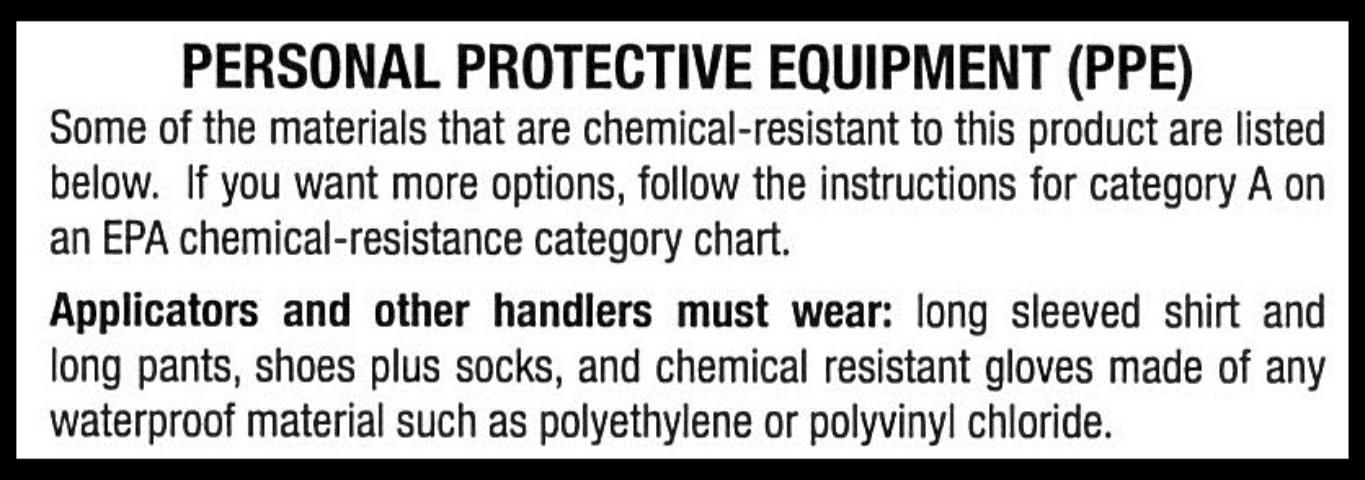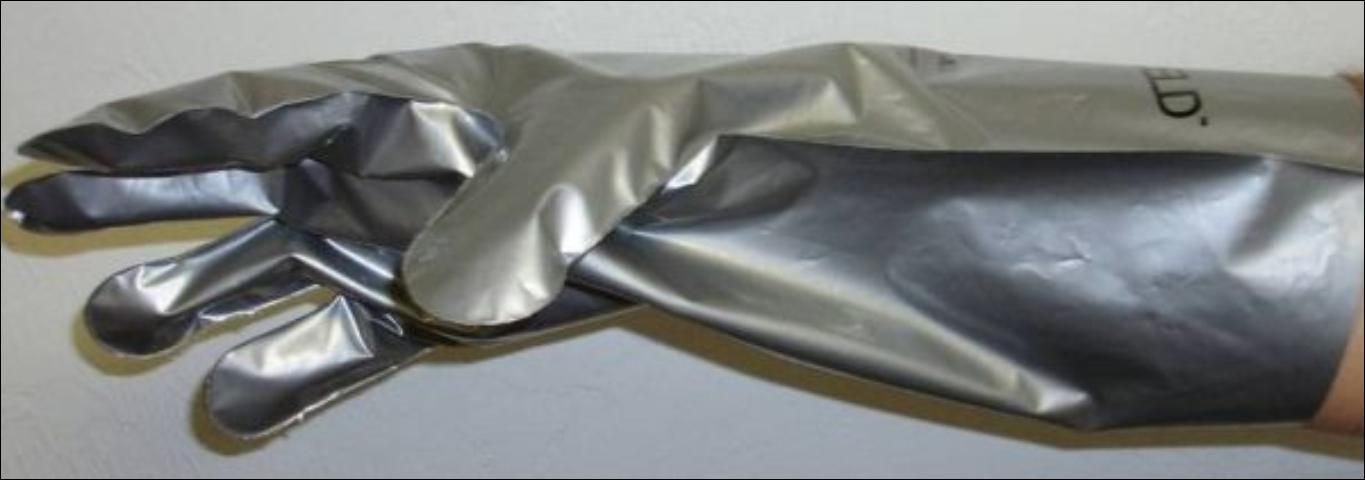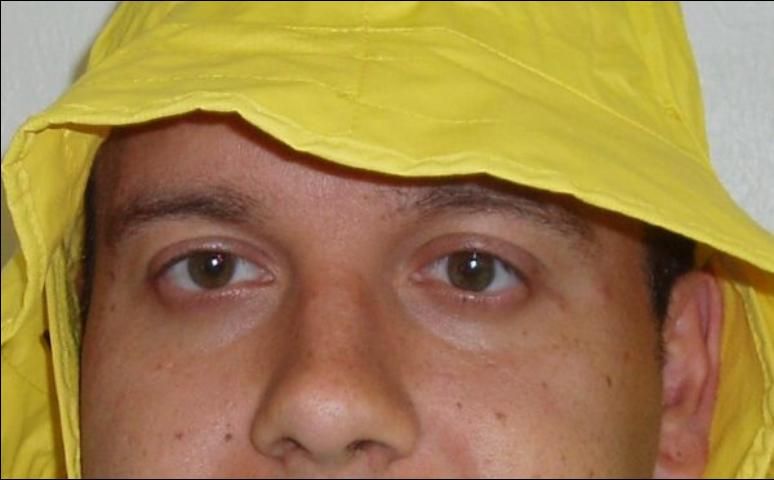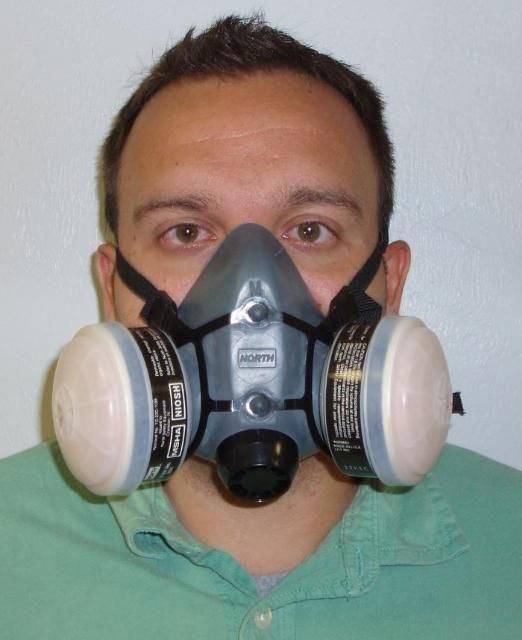This document describes various articles of personal protective equipment (PPE) that are worn to protect the human body from contact with pesticides or pesticide residues. PPE includes such items as coveralls or protective suits, footwear, gloves, aprons, respirators, eyewear, and headgear.
Introduction
Pesticides can pose hazards to humans. Hazard depends on the product's toxicity and length of exposure. The severity of a pesticide poisoning depends on the pesticide's chemical makeup and formulation, its path into the body, the amount that enters the body, and the length of exposure. Wearing PPE can greatly reduce the potential for dermal, inhalation, eye, and oral exposure, and thereby significantly reduce the chances of a pesticide poisoning, but does not necessarily eliminate it.
All pesticide handlers—applicators, mixer/loaders, flaggers, and early-entry agricultural workers—are legally required to follow all PPE instructions that appear on the product label. A pesticide label lists the minimum PPE that a person must wear while performing handling or early-entry activities (Figures 1 and 2).


Chemical-Resistant Clothing
The term chemical-resistant means that no measurable movement of the pesticide through the material occurs during the period of use. Some PPE is water resistant only. PPE that is water resistant will prevent a small amount of fine spray particles or small liquid splashes from penetrating the clothing and reaching the skin. Waterproof (liquid-proof) material keeps water-soluble materials out, but it may not necessarily keep out oil solvent-based products. Waterproof materials include items made of plastic or rubber. The chemical resistance of a material is an indication of how strongly it resists chemical penetration by pesticide products during use.
Always read the pesticide labeling to see if it states which materials are resistant to the pesticide product. In some instances, a pesticide label's PPE description lists a code letter (A-H) developed by the EPA to help the user select suitable PPE (Figure 3). The EPA Chemical Resistance Category Selection Chart is given in Table 1.

The chart's code letters are based on the solvents used in a pesticide product, not the pesticide's active ingredient. By referring to this chart, a pesticide handler can determine how long a given material can be expected to withstand chemical exposure by a given solvent. For example, the label directions from Figure 3 advise handlers to "refer to Category A on an EPA chemical-resistance category chart." Based on the chart's recommendations, any of the materials listed would be suitable for handling this product.
Protect Your Skin
According to an EPA report, most pesticide poisoning incidents occur through pesticides contacting the skin. PPE is protective only when used properly. If pesticide gets inside PPE next to the skin, the PPE will no longer protect the wearer. On the contrary, it will hold the pesticide against the skin as long as it is worn, increasing rather than decreasing the likelihood of contact injury or skin absorption and systemic injury.
Work Clothes
Ordinary shirts, pants, shoes, and other work clothes are usually not considered PPE, even though pesticide labels often indicate that specific items of work clothing should be worn during certain activities. The work clothes should be made of sturdy material and must be free of holes and tears. Shirt collars should be fastened completely to protect the lower part of the neck. The tighter the fabric weave, the better the protection. In some instances, the product label requires wearing a coverall, a chemical-resistant suit, or a chemical-resistant apron over work clothes.
Coveralls
The protection offered by chemical-resistant clothing depends on the fabric, and on design features such as flaps over zippers, elastic at the wrists and ankles, and seams that are bound and sealed. Coveralls should be made of sturdy material such as cotton, polyester, a cotton-synthetic blend, denim, or a non-woven fabric such as Tyvek® (Figures 4–6). When wearing a coverall, the opening should be closed securely so the entire body, except the feet, hands, neck, and head, is covered. With two-piece outfits, the shirt or coat should not be tucked in at the waist, but rather the shirt should extend well below the waist of the pants and fit loosely around the hips. Well-designed coveralls offering protection from pesticides are tightly constructed, and have sealed seams and snug, overlapping closures that do not allow gaps and do not unfasten readily. For example, many coveralls have zippers that are covered by flaps for added protection. Some coveralls, such as those made of Tyvek®, are water resistant and disposable.



Chemical-Resistant Suit
Some product labels require the handler to wear a chemical-resistant suit. This usually indicates the pesticide is very hazardous because of either acute or delayed effects. Chemical-resistant suits made of rubber or plastic are sold as one-piece coveralls or as two-piece outfits consisting of a jacket worn over coveralls. Chemical-resistant suits made of coated, non-woven fabric usually are sold as one-piece coveralls. The biggest drawback to chemical-resistant suits is they make the body uncomfortably warm. In Florida's climate, heat stress becomes a major concern.
Chemical-Resistant Apron
An apron protects from splashes and spills, and it protects coveralls or other clothing. Aprons should be considered whenever pesticide concentrates are handled. The pesticide label may require wearing a chemical-resistant apron when mixing or loading a pesticide or when cleaning application equipment. Some aprons are heavily constructed, but lightweight, disposable aprons are also commercially available (Figures 7–8).
An apron can pose a safety hazard when working around equipment with moving parts. In that situation, a chemical-resistant suit would be a better choice.


Gloves
The parts of the body that get the most exposure to pesticide are the hands and forearms. Research has shown that workers mixing pesticides received 85 percent of the total exposure to hands and 13 percent to the forearms. The same study showed wearing gloves reduced exposure by at least 98 percent to applicators who had spills while mixing or applying pesticides (Table 2). As a result, most product labels require use of waterproof or chemical-resistant gloves during handling and mixing. Gloves should be worn any time pesticides may contact hands, such as when working around contaminated equipment or surfaces (Figure 9).







Polymers used for chemical-resistant gloves (Figures 10–15) include those materials listed in Table 1. These materials are used either individually or in various combinations in commercially available gloves. Canvas and leather gloves will not protect against exposure to pesticides because these materials absorb pesticide easily and cannot be decontaminated.
Chemical-resistant gloves are fabricated in two forms. One is that of the hand silhouette. This glove is made by die-cutting a two-dimensional outline of a hand from a plastic film. Two of these flat hand forms are welded around the edges to form a glove. Most gloves made from polyethylene are constructed in this manner. The hand-silhouette gloves can be ineffective because of poor fit, loss of dexterity, and difficulty in keeping the gloves on the hands. The second and more common type of chemical-resistant glove is made by dip molding, that is, by dipping a hand mold into a polymer-containing liquid. Dipped gloves are right- and left-handed and are sized. These gloves provide both a better fit and improved dexterity. Some of the dipped gloves come with curved fingers, which provide additional comfort.
Glove thickness is described in units of mils (1 mil = 0.001 inch). In general, the effectiveness of the barrier and its resistance to tear and puncture increases with thickness. Commercially available gloves range in thickness from 1 to 60 mils. The most commonly used chemical-resistant gloves range from 12 to 22 mils.
Footwear
Pesticide handlers may get pesticides on their feet. Shoes and socks are often sufficient to protect your feet during many handling activities. When handling certain pesticides, however, canvas and leather shoes offer insufficient protection for the same reasons gloves made of these materials are not protective. The product labels for those pesticides require wearing waterproof or chemical-resistant footwear, which could mean shoe covers (Figure 16) or boots.
If a pesticide is likely to get on the lower legs or feet, chemical-resistant boots that extend past the ankles and at least halfway up to the knee should be worn. Wear waterproof boots when entering or walking through recently treated areas such as lawns before the spray has dried.

Wear Gloves and Footwear Correctly
Chemical-resistant gloves and footwear should not be worn when handling certain fumigants. The gloves and footwear can trap the fumigant gas near the skin and cause burns (Figure 17). Like other pesticides, fumigant labels specify the appropriate PPE required to protect the applicator from exposure.

If removing non-disposable gloves during a handling activity, the gloves should be thoroughly washed before removal. For jobs in which the arms are mostly lowered, the sleeves should be placed outside the gloves to prevent pesticide from running down into the gloves and onto the skin of the hands. For jobs in which the arms are mostly raised, gloves should remain outside the sleeves. Likewise, similar precautions should be observed with pant legs and boots. Pant legs should be outside of the boots to prevent pesticides from running down into the boots (Figure 18).

Overhead Protection
For overhead exposure or exposure to airborne particles, there are several PPE options. A plastic safari hat with plastic sweatbands is a good choice in hot weather. More flexible hats and hoods are also available in chemical-resistant materials (Figure 19).

Hats must not contain absorbent material such as cotton, leather, or straw. Many chemical-resistant jackets or coveralls can be purchased with attached protective hoods.
Protect Your Eyes
Eyes are very sensitive to the chemicals contained in some pesticide formulations, especially concentrates. Goggles, face shields, and safety glasses with shields at both the brow and sides are examples of protective eyewear (Figure 20–22).



Shielded safety glasses and full face shields are good choices in many handling situations because they are relatively comfortable, do not cause fogging or sweating, and provide good eye protection. If goggles will be worn, materials made of polycarbonate that have protected air baffles to avoid fogging are the most comfortable choice. Either goggles or shielded safety glasses can be worn with a half-face respirator (Figure 23).

If the Worker Protection Standard applies and if the label specifies goggles for eye protection, then regulations pertaining to eyewash decontamination are in effect.
Protect Your Respiratory Tract
Respirators protect from breathing pesticide-contaminated air. Various pesticide formulations require different types of respirators. The label will provide specific instructions if required, and if so, which type (Figure 24).

Respirators are the most specialized piece of personal protective equipment for working with pesticides, and proper selection is complicated. Specific information on choosing the appropriate respirator will be supplied by pesticide labels. Use only respirators approved by the National Institute of Occupational Safety and Health (NIOSH) and the Mine Safety and Health Administration (MSHA). Approved respirators will carry a "TC" number prefix, which signifies they have been tested and certified for a specific level of protection. If you plan to purchase a new respirator, a particulate respirator that formerly carried a TC-21C NIOSH prefix may carry a TC-84A prefix. NIOSH has developed a set of regulations in 42 CFR 84 (also referred to as "Part 84") for testing and certifying non-powered, air-purifying, particulate-filter respirators. The Part 84 respirators have passed a more demanding certification test than the old respirators (e.g., dust and mist [DM], dust, fume, and mist [DFM], spray paint, pesticide, etc.) certified under 30 CFR 11 (also referred to as "Part 11"). The following is a list showing several types of respirators and their TC code designations under the NIOSH classification system:
- TC-84A: non-powered particulate respirators (N, P, and R filters).
- TC-21C: powered particulate respirators only (100 series filters).
- TC-23C: chemical cartridge respirators.
- TC-14G: gas masks with canisters.
- TC-19C: supplied-air respirators.
- TC-13F: self-contained breathing apparatus.
Particulates are solid particles such as dusts and mists. Pesticide labels that specify organic vapor-removing cartridge respirators will also list which filters or pre-filters can be used with the respirator. The filters are identified by codes such as an HE, N, R or P, which indicate the level of oil resistance offered by the filter. "N" filters are not resistant to oils but are excellent for use with dusts and granular formulations. "R" and "P" filters are either oil-resistant (R) or oil-proof (P). HE filters refer to "high efficiency" filters for powered-air purifying units, which can be used with oils. Manufacturers will designate a number that follows the HE, N, R, or P on their products, and this number is an indication of the trapping efficiency. For example, a particulate respirator or filter with the N95 designation would be expected to have 95 percent efficiency in its trapping capacity. Pesticide label recommendations generally instruct the user to have a P100 filter with the chemical cartridge respirator when handling and applying oil-based pesticides.
One of the two common types of respirators is the air-purifying respirator. Some air-purifying respirators cover the entire face; there are also less expensive half-masks that cover the nose and mouth. These respirators should be used only where there is sufficient oxygen. Air-purifying respirators have chemical cartridges or mechanical filters to remove airborne contaminants as air enters the respirator. The chemical cartridges are filled with activated carbon, which has a very high absorption capacity for gases and vapors. Each chemical cartridge is color-coded to indicate the use for which it was designed. A description of these codes is listed in Table 3. Mechanical filters provide protection by trapping particulate matter in the porous filter material.
Most air-purifying respirators (Figures 25–26) operate under negative pressure; that is, they rely on the power of the wearer's lungs to pull air through the filter elements. These include half-mask dust/mist respirators, half-mask dual-cartridge respirators, full-face dual-cartridge respirators, and canister-type gas masks. Dust/mist respirators (Figure 27) and some half-mask dual-cartridge respirators are disposable. The only air-purifying respirator that operates under positive pressure is the powered air-purifying respirator (PAPR). It has a fan that pulls air through the filters and circulates it over the wearer's face. Air-purifying respirators vary widely in price.



The second basic type of respirator is the atmosphere-supplying respirator. This kind of respirator supplies an independent source of breathable air and is used in conditions where oxygen is deficient or the applicator is exposed to high concentrations of very toxic pesticides in enclosed areas. Breathable air is supplied to the wearer from an independent source through an air line, or the wearer carries oxygen in a tank. These respirators are relatively expensive and should be serviced and inspected by qualified personnel.
An applicator should perform a fit test to determine correct size of a respirator face piece because a respirator that does not provide a proper seal is of little value. OSHA mandates that a fit test be performed every time a person puts on a respirator. Instructions for conducting fit tests generally accompany half-mask and full-face respirators.
Chemical cartridges should be replaced according to the manufacturer's recommendations or the pesticide label, or when the wearer notices odor or experiences irritation. Pre-filters will extend the life of chemical cartridges in dusty conditions. Mechanical filters should be replaced when breathing becomes difficult or the filter is damaged, or as specified by the manufacturer or the pesticide label. If no instructions are provided, replace cartridges and filters when the workday is over.
Maintaining Personal Protective Equipment
When a pesticide handling activity is completed, PPE should be removed right away. The outside of the gloves should be washed with detergent and water before removing the rest of the PPE. Then, the outside of the other chemical-resistant items should be washed before removing the gloves.
Disposables
Disposable PPE items are not designed to be cleaned and reused, and should be discarded when they become contaminated with pesticides. Chemical-resistant gloves, footwear, and aprons labeled as disposable are designed to be worn only once and then thrown away. These items are made of thin vinyl, latex, or polyethylene. These inexpensive disposables may be a good choice for brief pesticide handling activities that require dexterity, as long as the activity does not tear the thin plastic.
Reusables
Some PPE items, such as rubber and plastic suits, gloves, boots, aprons, capes, and headgear, are designed to be cleaned and reused several times. However, they should not continue to be worn when they no longer are able to provide adequate protection. They can be checked for rips and leaks by using the rinse water to form a "balloon" and/or holding the items up to the light. Even if there are no obvious signs of wear, reusable PPE items should be replaced regularly. The ability of a chemical-resistant material to resist pesticides decreases each time the item is worn. A good rule of thumb is to throw out gloves that have been worn for about 5 to 7 workdays. Extra-heavy-duty gloves, such as those made of butyl or nitrile rubber, may last as long as 10 to 14 days. The cost of frequently replacing gloves is a wise investment. Footwear, aprons, headgear, and protective suits may last longer than gloves because they generally receive less exposure to the pesticides and less abrasion from rough surfaces. Most protective eyewear and respirator bodies, face pieces, and helmets are designed to be cleaned and reused. These items can last many years if they are of good quality and are maintained correctly.
Washing PPE
Pesticide-contaminated items should be washed separately from the family laundry. The following procedure can be used for washing non-chemical-resistant items such as cotton, cotton/polyester, denim, canvas, and other absorbent materials, and for most chemical-resistant items.
Procedure for Washing Contaminated PPE
- Wash only a few items at a time so there is plenty of agitation and water for dilution.
- Wash in a washing machine, using heavy-duty liquid detergent and hot water for the wash cycle. Set the washer to the longest wash cycle and two rinse cycles.
- Use two entire machine cycles to wash items that are moderately to heavily contaminated. If PPE is too contaminated, bundle it in a plastic bag, label the bag, and take it to a household hazardous waste collection site.
- Run the washer through at least one additional entire cycle without clothing, using detergent and hot water, to clean the machine before any other laundry is washed.
- Hang the washed items to dry, if possible. It is best to let them hang for at least 24 hours in an area with plenty of fresh air.
Maintaining Eyewear and Respirators
Wash goggles, face shields, shielded safety glasses, respirator bodies, and face pieces after each day of use. Use detergent and hot water to wash them thoroughly. They should be sanitized by soaking for at least 2 minutes in a mixture of 2 tablespoons of chlorine bleach in 1 gallon of hot water, then rinsed thoroughly. Following rinsing, the items should be allowed to dry thoroughly by hanging them in a clean area. Store respirators and eyewear in an area where they are protected from dust, sunlight, extreme temperatures, excessive moisture, and pesticides or other chemicals. A sturdy plastic bag with a zip closure works well for storage (Figure 28).

Additional Information
Acquavella, J. et al. 2004. "Glyphosate Biomonitoring for Farmer-Applicators and Their Families: Results from the Farm Family Exposure Study." Environ. Health Perspect:112:321–326. https://www.ncbi.nlm.nih.gov/pmc/articles/PMC1241861/ (accessed October 2018).
Fishel, F.M. 2009. Farm Family Exposure to Glyphosate. PI-178. Gainesville: University of Florida Institute of Food and Agricultural Sciences. https://journals.flvc.org/edis/article/view/117922 (accessed May 2022).
Fishel, F.M. 2006. Glove Selection for Working with Pesticides. PI-120. Gainesville: University of Florida Institute of Food and Agricultural Sciences. https://journals.flvc.org/edis/article/view/115783 (accessed May 2022).
Fishel, F.M. 2005. Interpreting Pesticide Label Wording. PI-34. Gainesville: University of Florida Institute of Food and Agricultural Sciences. https://journals.flvc.org/edis/article/view/114596 (accessed May 2022).
Fishel, F.M. 2008. Protecting Your Eyes from Pesticide Exposure. PI-165. Gainesville: University of Florida Institute of Food and Agricultural Sciences. https://journals.flvc.org/edis/article/view/117451 (accessed May 2022).
Fishel, F.M. 2005. Respirators for Pesticide Applications. PI-77. Gainesville: University of Florida Institute of Food and Agricultural Sciences. https://journals.flvc.org/edis/article/view/115153 (accessed May 2022).
Fishel, F.M. 2005. Understanding Material Safety Data Sheet Language. PI-35. Gainesville: University of Florida Institute of Food and Agricultural Sciences. https://journals.flvc.org/edis/article/view/114597 (accessed May 2022).
Nesheim, O.N., F.M. Fishel, and M.A. Mossler. Toxicity of Pesticides. PI-13. Gainesville: University of Florida Institute of Food and Agricultural Sciences. https://edis.ifas.ufl.edu/publication/pi008 (accessed May 2022).
Roberts, R.R. and J.R. Reigart. 2013. Recognition and management of pesticide poisonings 6th ed. U.S. EPA